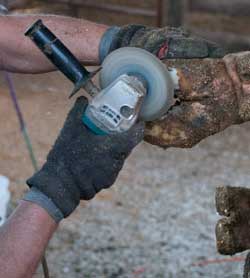
by Amanda Smith, Associate Editor
Hoof trimming has become a Formula 1 race. Yet, it's not about how many cows can be trimmed in a day. It's about preventing lameness.
As with any profession, hoof trimmers need to be paid for a job well done. Too often, though, they're paid for the hoof chips that are left on the ground, noted Karl Burgi, Sure Step Consulting, at the Leading Dairy Producers Conference. During his presentation, Burgi highlighted six common hoof trimming problems:
- Trimming toes too short. This leads to toe ulcers.
- Excessive trimming. The heel of the inside claw should never be white.
- Removal of the axial or inside wall of the toe. This removes the pillars that cows need to stand.
- Excessive removal of the outside wall. "This is the same as thinning a wall of a building; if we take the walls away, the roof collapses," noted Burgi.
- Trimming the sole of claws with extreme concavity. Soles need to be flat.
- Trimming the sole too thin. Preserving sole thickness at the toes is the top priority.
It's your job to present the right cows to the trimmer.
"Every dry cow and springing heifer should be assessed and functionally trimmed eight to three weeks prior to calving," Burgi added.
If needed, first-lactation cows should have their next trim at 125 days in milk. Older cows should have their next trim between 80 to 125 days, depending on the environment. All cows should be evaluated 120 days thereafter.
When there are too many lame cows, maintenance trimming slots are eliminated. In turn, lameness prevention then suffers and ultimately rises.
(c) Hoard's Dairyman Intel 2015
March 2, 2015








